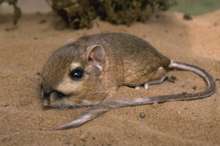| Heermann's kangaroo rat | |
|---|---|

| |
| Scientific classification | |
| Domain: | Eukaryota |
| Kingdom: | Animalia |
| Phylum: | Chordata |
| Class: | Mammalia |
| Order: | Rodentia |
| Family: | Heteromyidae |
| Genus: | Dipodomys |
| Species: | D. heermanni
|
| Binomial name | |
| Dipodomys heermanni Le Conte, 1853
| |
Heermann's kangaroo rat (Dipodomys heermanni) is a species of rodent in the family Heteromyidae.[2] Their long smooth pelage resembles typical kangaroo rats, with their dorsal side showing a mixed range of olive, black and orange colors.[3] There are 9 distinguished sub-species of Dipodomys heermanni: D.h. arenae, D.h. berkeleyensis, D.h. dixoni, D.h. goldmani, D.h. heermanni, D.h. jolonensis, D.h.morroensis, D.h. swarthi, and D.h. tularensis.[4] The dental formula of Dipodomys heermanni is 1.0.1.31.0.1.3 × 2 = 20.[5]
It is considered "broad-faced", unlike many other species of kangaroo rats, which are considered to be "narrow-faced". It has five toes on each hind foot, and this small characteristic is important in distinguishing it from similar species such as Dipodomys californicus and Dipodomys nitratoides. Additionally it is smaller than Dipodomys ingens, Dipodomys venustus, and Dipodomys elephantinus.[3]
Heermann's kangaroo rat averages a total length of 250–313 mm (9.8–12.3 in), with their tail measuring 160–200 mm (6.3–7.9 in), their hind foot measuring 38–46 mm (1.5–1.8 in), and their ear measuring 10–17 mm (0.39–0.67 in).[3] Additionally when looking at all standard external measurements it has been found they demonstrate significant sexual dimorphism.[5]
It is named after Adolphus Lewis Heermann, who collected the holotype of this species.[6]
- ^ Cassola, F. (2016). "Dipodomys heermanni". IUCN Red List of Threatened Species. 2016: e.T42600A22227931. doi:10.2305/IUCN.UK.2016-2.RLTS.T42600A22227931.en. Retrieved 13 November 2021.
- ^ Patton, J.L. (2005). "Family Heteromyidae". In Wilson, D.E.; Reeder, D.M (eds.). Mammal Species of the World: A Taxonomic and Geographic Reference (3rd ed.). Johns Hopkins University Press. pp. 845–846. ISBN 978-0-8018-8221-0. OCLC 62265494.
- ^ a b c Grinnell, Joseph (1922). "A Geographical Study of the Kangaroo Rats of California". Journal of Mammalogy. 3: 264–267. doi:10.2307/1373259. hdl:2027/hvd.32044107347767. JSTOR 1373259.
- ^ "Dipodomys heermanni". Integrated Taxonomic Information System. Retrieved 2017-12-04.
- ^ a b Kelt, Douglas A. (27 December 1988). "Dipodomys heermanni" (PDF). Mammalian Species (323). The American Society of Mammalogists: 1–7. doi:10.2307/3504171. JSTOR 3504171. Archived from the original (PDF) on 2015-11-18.
- ^ Beolens, Bo; Watkins, Michael; Grayson, Michael (2009). The Eponym Dictionary of Mammals. 2715 North Charles Street Baltimore, Maryland 21218-4363: Johns Hopkins University Press. p. 183. ISBN 9780801893049.
{{cite book}}: CS1 maint: location (link)
